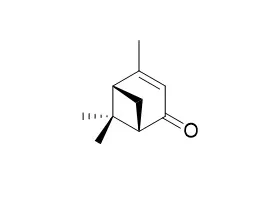| In vitro: |
| Drug Metabolism & Disposition the Biological Fate of Chemicals, 2003, 31(8):1049-53. | | Roles of human CYP2A6 and 2B6 and rat CYP2C11 and 2B1 in the 10-hydroxylation of (-)-verbenone by liver microsomes.[Pubmed: 12867494 ] | (-)-Verbenone, a monoterpene bicyclic ketone, is a component of the essential oil from rosemary species such as Rosmarinus officinalis L., Verbena triphylla, and Eucalyptus globulus and is used for an herb tea, a spice, and a perfume.
METHODS AND RESULTS:
In this study, (-)-Verbenone was found to be converted to 10-hydroxyverbenone by rat and human liver microsomal cytochrome p450 (p450) enzymes. The product formation was determined by high-performance liquid chromatography with UV detection at 251 nm. There was a good correlation between activities of coumarin 7-hydroxylation and (-)-Verbenone 10-hydroxylation catalyzed by liver microsomes of 16 human samples, indicating that CYP2A6 is a principal enzyme in (-)-Verbenone 10-hydroxylation in humans. Human recombinant CYP2A6 and CYP2B6 catalyzed (-)verbenone 10-hydroxylation at Vmax values of 15 and 21 nmol/min/nmol p450 with apparent Km values of 16 and 91 microM, respectively. In contrast, rat CYP2A1 and 2A2 did not catalyze (-)-Verbenone 10-hydroxylation at all, suggesting that there were species-related differences in the catalytic properties of human and rat CYP2A enzymes in the metabolism of (-)-Verbenone. In the rat, recombinant CYP2C11, CYP2B1, and CYP3A2 catalyzed (-)-Verbenone 10-hydroxylation with Vmax and Km ratios (ml/min/nmol p450) of 0.73, 0.20, and 0.03, respectively. Male-specific CYP2C11 was a major enzyme in (-)-Verbenone 10-hydroxylation by untreated rat livers, and CYP2B1 catalyzed this reaction in liver microsomes of phenobarbital-treated rats. Rat CYP2C12, a female-specific enzyme, did not catalyze (-)verbenone 10-hydroxylation.
CONCLUSIONS:
These results suggest that human CYP2A6 and rat CYP2C11 are the major catalysts in the metabolism of (-)-Verbenone by liver microsomes and that there are species-related differences in human and rat CYP2A enzymes and sex-related differences in male and female rats in the metabolism of (-)-Verbenone. | | Russian Chemical Bulletin, 2015, 64(9):2257-2260. | | Synthesis and cytotoxic activity of substituted hexahydro-2H-4,6-(epoxymethano)chromen-8(5H)-ones obtained from (-)-verbenone.[Reference: WebLink] | A number of compounds with a substituted hexahydro-2 H -4,6-(epoxymethano)chromen8(5 H )-one framework was synthesized starting from monoterpenoid (-)-Verbenone and aromatic aldehydes containing methoxy and hydroxy groups.
METHODS AND RESULTS:
Cytotoxic activity of these compounds on human tumor cell lines was studied for the first time. Compounds containing three methoxy groups in each aromatic ring were found to be the most promising for further studies. | | Drug Development Communications, 1999, 25(8):905-915. | | Influence of Drug Lipophilicity on Terpenes as Transdermal Penetration Enhancers.[Reference: WebLink] |
METHODS AND RESULTS:
Percutaneous absorption-enhancing effects on the skin of hairless mice of 11 monoterpenes [1, (+)-limonene; 2, (−)-menthone; 3, (+)-terpinen-4-ol; 4, α-terpineol; 5, 1,8-cineole; 6, (+)-carvone; 7, (-)-Verbenone; 8, (−)-fenchone; 9, p-cymene; 10, (+)-neomenthol; and 11, geraniol] were investigated using three different model drugs (caffeine, hydrocortisone, triamcinolone acetonide [TA]) with varying lipophilicities. Terpenes were applied at 0.4 M in propylene glycol (PG) to mouse skin. The model drugs were applied as suspensions in PG 1 hr following enhancer pretreatment. The combination of terpenes in PG provided significant enhancement of the permeation of caffeine through mouse skin. The most active compounds 10 and 11 increased permeation by between 13-fold and 16-fold. The terpenes also enhanced the delivery of hydrocortisone, but not to as great an extent. The most active compounds 3 and 4 increased permeation between 3.9-fold and 5-fold. The compounds examined did not significantly increase the delivery of TA. The most active compound 4 only increased delivery 2.5-fold, while the next most active compound 6 only increased delivery 1.7-fold.
CONCLUSIONS:
Overall, these results indicate that the combination of terpenes with PG can significantly increase the transdermal penetration of the hydrophilic drug caffeine and the polar steroid hydrocortisone. |
|






 Cell. 2018 Jan 11;172(1-2):249-261.e12. doi: 10.1016/j.cell.2017.12.019.IF=36.216(2019)
Cell. 2018 Jan 11;172(1-2):249-261.e12. doi: 10.1016/j.cell.2017.12.019.IF=36.216(2019) Cell Metab. 2020 Mar 3;31(3):534-548.e5. doi: 10.1016/j.cmet.2020.01.002.IF=22.415(2019)
Cell Metab. 2020 Mar 3;31(3):534-548.e5. doi: 10.1016/j.cmet.2020.01.002.IF=22.415(2019) Mol Cell. 2017 Nov 16;68(4):673-685.e6. doi: 10.1016/j.molcel.2017.10.022.IF=14.548(2019)
Mol Cell. 2017 Nov 16;68(4):673-685.e6. doi: 10.1016/j.molcel.2017.10.022.IF=14.548(2019)